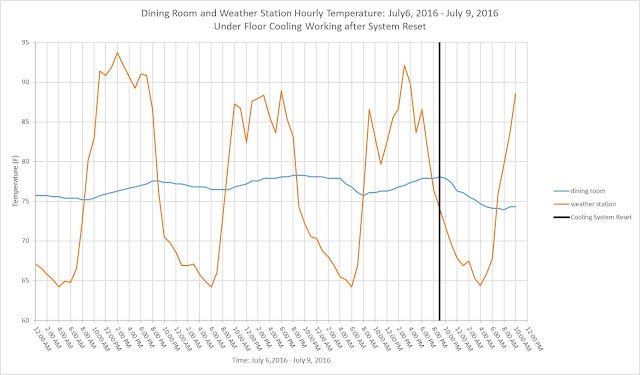The energy features of our Huf Hauf green (r)evolution home are highly automated including our unique Bosch geothermal system and hot water heater configuation, Zehnder ventilation system, SMA solar arrays and photovoltaic system, our very high tech shutters and our underfloor cooling system. In other words, our home is much smarter than a home with Nest, Lutron and Euro systems as mentioned in their guest editor Dave Morin's essay
(although any Tesla puts our Volt to shame; we are on a waiting list for Model III).
And, in many ways our home was designed and constructed around its technology because of the close collaboration between Huf Haus and their energy partner redblue Energy. The problem of interoperability has been solved; most of the systems use a common Domovea server.. But the past six weeks have been a testament to the difficulty of keeping home technology functioning smoothly and what to do if it isn't.
This is our 3rd summer in the house. Our underfloor cooling system should kick in when a threshold temperature is reached (23 degree Celsius) and in June, it didn't. The system is controlled by our Exigo unit which integrates the flow of brine from our geothermal heat pump which is circulated via a heat exchanger throughout both floors of our home using a series of valves and circuits. As far as residential and commercial systems go, our system is relatively simple: eight temperature sensors and seven relay outputs (which control the pumps and valves). When the system fails, the problem could be in any of the component parts. Ours occurred after a power outage and a remote cold restart from our apartment, but that may not have been related.
Over several weekends, my husband Steve did some local trouble-shooting by resetting a mind-boggling number of thermal parameters in the system. He has a technical background (structural engineering) but this proved to be very challenging and time consuming. He got the system working for a short time but then had to contact redblue Energy for support. They were able to make the adjustments from their corporate home in Muschenbach Germany (converting our digital link from English language to German then back again). Our dilemma is that the technical expertise to keep this house functioning doesn't reside in the US. But for now, the floors are wonderfully cool (18 degrees Celsius or 64 degrees Farenheit).
Another not-so-minor technological glitch in our smart house is that the fact that our Sunny Webbox wireless system
apparently can never provide data from our three solar arrays. The box was installed but the panels don't recognize it. The data is easily visible from the individual arrays as shown below
and Steve continues to track our huge surplus manually (13,000 kilowatt-hours).
Speaking of Steve, he has expressed reluctance at blogging about the cost of our project, primarily because of the possibility that everyone except for the two of us will think that this home wasn't worth it or that we could have done it for a lot less. So before I outline the costs (after many requests from pageviewers), please remember the most important point from Chapter 1 - we wanted a one of a kind house and we have one and love it. Although Huf Haus is expanding into Romania
they are not likely to ever build another home in the US at any price, We plan to live here as long as we are physically and mentally able to, and then we will convey it back to the Western Pennsylvania Conservancy in perpetuity.
Land (Western Pennsylvania Conservancy) $300,000
Design and drawings $ 10,000
Construction costs (CPK Construction) $173,190
This included the foundation, the wells, and ground work.
Contract price (Huf Haus) 1.128.779 Euros
To end on a beautiful note, our newly planted wildflower mix is flourishing. Our hummingbirds and pollinators are happy and so are we.






















































